Haozhe Liu
Mixture of States: Routing Token-Level Dynamics for Multimodal Generation
Nov 15, 2025Abstract:We introduce MoS (Mixture of States), a novel fusion paradigm for multimodal diffusion models that merges modalities using flexible, state-based interactions. The core of MoS is a learnable, token-wise router that creates denoising timestep- and input-dependent interactions between modalities' hidden states, precisely aligning token-level features with the diffusion trajectory. This router sparsely selects the top-$k$ hidden states and is trained with an $ε$-greedy strategy, efficiently selecting contextual features with minimal learnable parameters and negligible computational overhead. We validate our design with text-to-image generation (MoS-Image) and editing (MoS-Editing), which achieve state-of-the-art results. With only 3B to 5B parameters, our models match or surpass counterparts up to $4\times$ larger. These findings establish MoS as a flexible and compute-efficient paradigm for scaling multimodal diffusion models.
Addressing Missing Data Issue for Diffusion-based Recommendation
May 18, 2025Abstract:Diffusion models have shown significant potential in generating oracle items that best match user preference with guidance from user historical interaction sequences. However, the quality of guidance is often compromised by unpredictable missing data in observed sequence, leading to suboptimal item generation. Since missing data is uncertain in both occurrence and content, recovering it is impractical and may introduce additional errors. To tackle this challenge, we propose a novel dual-side Thompson sampling-based Diffusion Model (TDM), which simulates extra missing data in the guidance signals and allows diffusion models to handle existing missing data through extrapolation. To preserve user preference evolution in sequences despite extra missing data, we introduce Dual-side Thompson Sampling to implement simulation with two probability models, sampling by exploiting user preference from both item continuity and sequence stability. TDM strategically removes items from sequences based on dual-side Thompson sampling and treats these edited sequences as guidance for diffusion models, enhancing models' robustness to missing data through consistency regularization. Additionally, to enhance the generation efficiency, TDM is implemented under the denoising diffusion implicit models to accelerate the reverse process. Extensive experiments and theoretical analysis validate the effectiveness of TDM in addressing missing data in sequential recommendations.
Can Video Diffusion Model Reconstruct 4D Geometry?
Mar 27, 2025Abstract:Reconstructing dynamic 3D scenes (i.e., 4D geometry) from monocular video is an important yet challenging problem. Conventional multiview geometry-based approaches often struggle with dynamic motion, whereas recent learning-based methods either require specialized 4D representation or sophisticated optimization. In this paper, we present Sora3R, a novel framework that taps into the rich spatiotemporal priors of large-scale video diffusion models to directly infer 4D pointmaps from casual videos. Sora3R follows a two-stage pipeline: (1) we adapt a pointmap VAE from a pretrained video VAE, ensuring compatibility between the geometry and video latent spaces; (2) we finetune a diffusion backbone in combined video and pointmap latent space to generate coherent 4D pointmaps for every frame. Sora3R operates in a fully feedforward manner, requiring no external modules (e.g., depth, optical flow, or segmentation) or iterative global alignment. Extensive experiments demonstrate that Sora3R reliably recovers both camera poses and detailed scene geometry, achieving performance on par with state-of-the-art methods for dynamic 4D reconstruction across diverse scenarios.
Distinguished Quantized Guidance for Diffusion-based Sequence Recommendation
Jan 29, 2025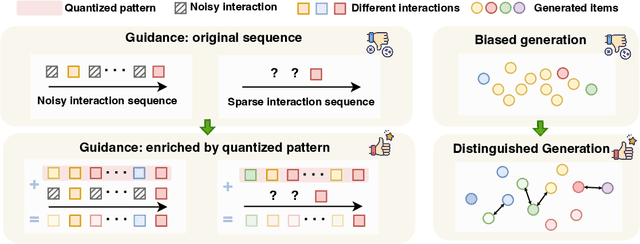

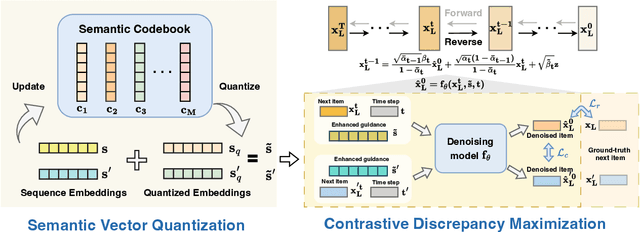
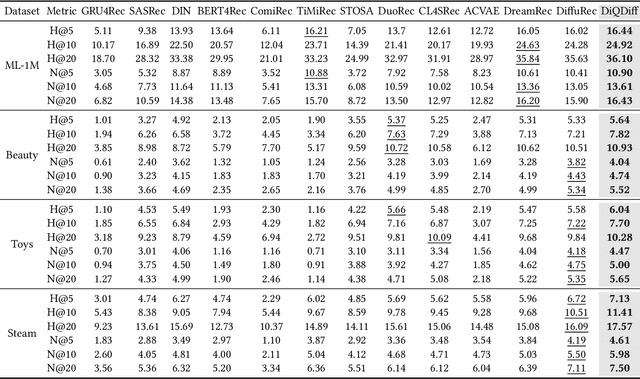
Abstract:Diffusion models (DMs) have emerged as promising approaches for sequential recommendation due to their strong ability to model data distributions and generate high-quality items. Existing work typically adds noise to the next item and progressively denoises it guided by the user's interaction sequence, generating items that closely align with user interests. However, we identify two key issues in this paradigm. First, the sequences are often heterogeneous in length and content, exhibiting noise due to stochastic user behaviors. Using such sequences as guidance may hinder DMs from accurately understanding user interests. Second, DMs are prone to data bias and tend to generate only the popular items that dominate the training dataset, thus failing to meet the personalized needs of different users. To address these issues, we propose Distinguished Quantized Guidance for Diffusion-based Sequence Recommendation (DiQDiff), which aims to extract robust guidance to understand user interests and generate distinguished items for personalized user interests within DMs. To extract robust guidance, DiQDiff introduces Semantic Vector Quantization (SVQ) to quantize sequences into semantic vectors (e.g., collaborative signals and category interests) using a codebook, which can enrich the guidance to better understand user interests. To generate distinguished items, DiQDiff personalizes the generation through Contrastive Discrepancy Maximization (CDM), which maximizes the distance between denoising trajectories using contrastive loss to prevent biased generation for different users. Extensive experiments are conducted to compare DiQDiff with multiple baseline models across four widely-used datasets. The superior recommendation performance of DiQDiff against leading approaches demonstrates its effectiveness in sequential recommendation tasks.
Learning Flow Fields in Attention for Controllable Person Image Generation
Dec 12, 2024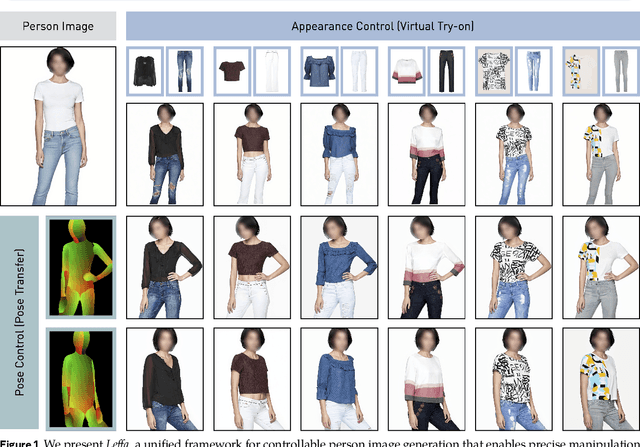
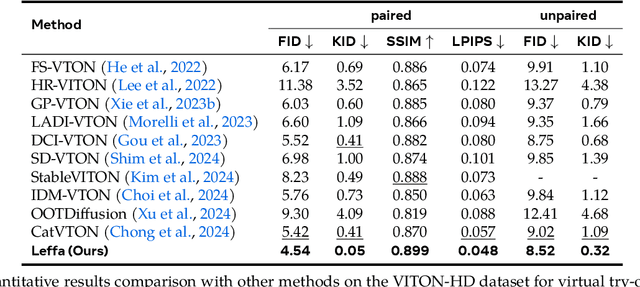
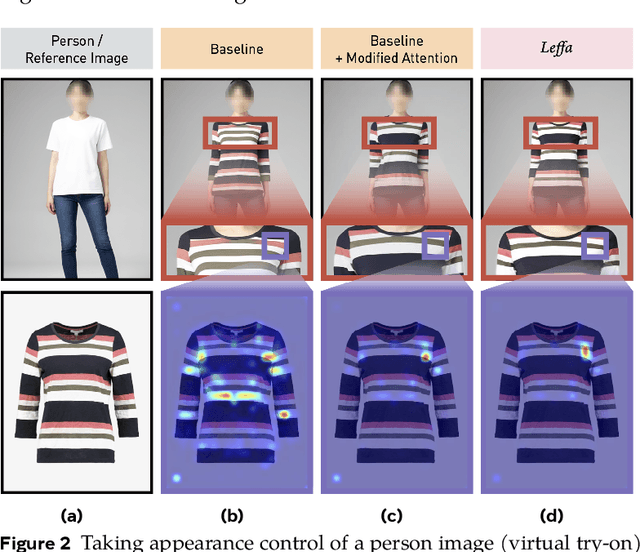

Abstract:Controllable person image generation aims to generate a person image conditioned on reference images, allowing precise control over the person's appearance or pose. However, prior methods often distort fine-grained textural details from the reference image, despite achieving high overall image quality. We attribute these distortions to inadequate attention to corresponding regions in the reference image. To address this, we thereby propose learning flow fields in attention (Leffa), which explicitly guides the target query to attend to the correct reference key in the attention layer during training. Specifically, it is realized via a regularization loss on top of the attention map within a diffusion-based baseline. Our extensive experiments show that Leffa achieves state-of-the-art performance in controlling appearance (virtual try-on) and pose (pose transfer), significantly reducing fine-grained detail distortion while maintaining high image quality. Additionally, we show that our loss is model-agnostic and can be used to improve the performance of other diffusion models.
Adaptive Caching for Faster Video Generation with Diffusion Transformers
Nov 04, 2024



Abstract:Generating temporally-consistent high-fidelity videos can be computationally expensive, especially over longer temporal spans. More-recent Diffusion Transformers (DiTs) -- despite making significant headway in this context -- have only heightened such challenges as they rely on larger models and heavier attention mechanisms, resulting in slower inference speeds. In this paper, we introduce a training-free method to accelerate video DiTs, termed Adaptive Caching (AdaCache), which is motivated by the fact that "not all videos are created equal": meaning, some videos require fewer denoising steps to attain a reasonable quality than others. Building on this, we not only cache computations through the diffusion process, but also devise a caching schedule tailored to each video generation, maximizing the quality-latency trade-off. We further introduce a Motion Regularization (MoReg) scheme to utilize video information within AdaCache, essentially controlling the compute allocation based on motion content. Altogether, our plug-and-play contributions grant significant inference speedups (e.g. up to 4.7x on Open-Sora 720p - 2s video generation) without sacrificing the generation quality, across multiple video DiT baselines.
MarDini: Masked Autoregressive Diffusion for Video Generation at Scale
Oct 26, 2024



Abstract:We introduce MarDini, a new family of video diffusion models that integrate the advantages of masked auto-regression (MAR) into a unified diffusion model (DM) framework. Here, MAR handles temporal planning, while DM focuses on spatial generation in an asymmetric network design: i) a MAR-based planning model containing most of the parameters generates planning signals for each masked frame using low-resolution input; ii) a lightweight generation model uses these signals to produce high-resolution frames via diffusion de-noising. MarDini's MAR enables video generation conditioned on any number of masked frames at any frame positions: a single model can handle video interpolation (e.g., masking middle frames), image-to-video generation (e.g., masking from the second frame onward), and video expansion (e.g., masking half the frames). The efficient design allocates most of the computational resources to the low-resolution planning model, making computationally expensive but important spatio-temporal attention feasible at scale. MarDini sets a new state-of-the-art for video interpolation; meanwhile, within few inference steps, it efficiently generates videos on par with those of much more expensive advanced image-to-video models.
Highway Reinforcement Learning
May 28, 2024



Abstract:Learning from multi-step off-policy data collected by a set of policies is a core problem of reinforcement learning (RL). Approaches based on importance sampling (IS) often suffer from large variances due to products of IS ratios. Typical IS-free methods, such as $n$-step Q-learning, look ahead for $n$ time steps along the trajectory of actions (where $n$ is called the lookahead depth) and utilize off-policy data directly without any additional adjustment. They work well for proper choices of $n$. We show, however, that such IS-free methods underestimate the optimal value function (VF), especially for large $n$, restricting their capacity to efficiently utilize information from distant future time steps. To overcome this problem, we introduce a novel, IS-free, multi-step off-policy method that avoids the underestimation issue and converges to the optimal VF. At its core lies a simple but non-trivial \emph{highway gate}, which controls the information flow from the distant future by comparing it to a threshold. The highway gate guarantees convergence to the optimal VF for arbitrary $n$ and arbitrary behavioral policies. It gives rise to a novel family of off-policy RL algorithms that safely learn even when $n$ is very large, facilitating rapid credit assignment from the far future to the past. On tasks with greatly delayed rewards, including video games where the reward is given only at the end of the game, our new methods outperform many existing multi-step off-policy algorithms.
Lazy Layers to Make Fine-Tuned Diffusion Models More Traceable
May 01, 2024



Abstract:Foundational generative models should be traceable to protect their owners and facilitate safety regulation. To achieve this, traditional approaches embed identifiers based on supervisory trigger-response signals, which are commonly known as backdoor watermarks. They are prone to failure when the model is fine-tuned with nontrigger data. Our experiments show that this vulnerability is due to energetic changes in only a few 'busy' layers during fine-tuning. This yields a novel arbitrary-in-arbitrary-out (AIAO) strategy that makes watermarks resilient to fine-tuning-based removal. The trigger-response pairs of AIAO samples across various neural network depths can be used to construct watermarked subpaths, employing Monte Carlo sampling to achieve stable verification results. In addition, unlike the existing methods of designing a backdoor for the input/output space of diffusion models, in our method, we propose to embed the backdoor into the feature space of sampled subpaths, where a mask-controlled trigger function is proposed to preserve the generation performance and ensure the invisibility of the embedded backdoor. Our empirical studies on the MS-COCO, AFHQ, LSUN, CUB-200, and DreamBooth datasets confirm the robustness of AIAO; while the verification rates of other trigger-based methods fall from ~90% to ~70% after fine-tuning, those of our method remain consistently above 90%.
Cross-Attention Makes Inference Cumbersome in Text-to-Image Diffusion Models
Apr 03, 2024Abstract:This study explores the role of cross-attention during inference in text-conditional diffusion models. We find that cross-attention outputs converge to a fixed point after few inference steps. Accordingly, the time point of convergence naturally divides the entire inference process into two stages: an initial semantics-planning stage, during which, the model relies on cross-attention to plan text-oriented visual semantics, and a subsequent fidelity-improving stage, during which the model tries to generate images from previously planned semantics. Surprisingly, ignoring text conditions in the fidelity-improving stage not only reduces computation complexity, but also maintains model performance. This yields a simple and training-free method called TGATE for efficient generation, which caches the cross-attention output once it converges and keeps it fixed during the remaining inference steps. Our empirical study on the MS-COCO validation set confirms its effectiveness. The source code of TGATE is available at https://github.com/HaozheLiu-ST/T-GATE.
 Add to Chrome
Add to Chrome Add to Firefox
Add to Firefox Add to Edge
Add to Edge